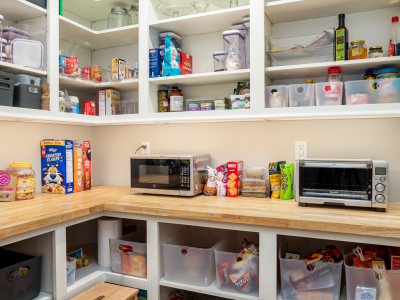
12 Steps to a Perfectly Organized Pantry
Does your pantry resemble a disaster zone? No worries. Storage areas are notorious for becoming messy and disorganized.
If you are lucky enough to have dedicated pantry space, it will be much easier to use it and keep it organized if you take time to create a comprehensive and thoughtful system.
Here are a dozen steps that will help you bring perfection to your pantry and keep it in tip-top shape!
1. Empty the Pantry
Before you begin organizing, remove everything from your pantry. Take note: when organizing, everything looks worse before it looks better.
2. Check the Dates
Make sure everything stored in your pantry is still fresh. Check the “best used by” date. If an item has expired, consider tossing it or using it immediately. Any saved items can go into a bin labeled “Use ASAP.”
3. Start with a Clean Slate
While the pantry is empty, scrub down the shelves, walls, and floor. Food storage spaces need to be cleaned regularly to prevent spills or sticky residues from attracting bugs or rodents.
4. Eliminate What You Never Use
Set aside items that have good dates, but aren’t being used. If the package is already open, you may want to add it to the “Use ASAP” box.
If the food is still sealed, consider giving it to a member of your family, a friend, or donating it to a local food pantry. Pantry space is precious and should not be wasted on things your family doesn’t like and won’t use.
5. Position Prime Foodstuffs
Store your most-used items together, and at eye level, so they’re easy to access and, more importantly, easy to put away. This will help prevent your freshly cleaned and organized pantry from becoming messy again.
6. Organize by Type
When you have a designated spot for everything, it’s easier to find what you need when you need it. It will also prevent duplicate purchases from getting misplaced and “lost” in your pantry.
For example, you can position all your baking goods in one well-defined area or a labeled basket (or baskets).
If all your soups are together in rows, by type, it will be easy to find the kind of soup you want and tell when you need to buy more of anything.
7. Organize By Date
When you return everything to the shelves, be sure any duplicates are positioned so soon-to-expire items are in the front of things that will stay fresh longer. When you buy replacements, be sure to place them behind the older stock, just like grocery stores do.
8. Determine Quantities and Space
If you decide in advance how much you need of each item, based on the way you and your family eat, it will be easier to keep your pantry well-stocked. Adjust shelves so you can conveniently stack cans and jars and dedicate the necessary number of rows for everything.
Or, you may want to use baskets to group items. Consider adding labels to the edge of the shelf, or on the baskets, to identify where things go.
Each time you use a can of tuna, for example, you can add one to your shopping list, so it’s easy to purchase a replacement the next time you’re at the store.
If you have a few remaining odds and ends that you only use occasionally, consider a “Specialty Items” basket where these things can be kept in one easy to locate place—together!
9. Group Items By Use
When making decisions about quantities and space, think about how you cook and snack, then group pantry items according to your preferences.
If, for instance, you often have oatmeal for breakfast, collect all the possible ingredients on a tray, potentially including oats, nuts, cinnamon, dried fruit, brown sugar, honey, etc.
This will reduce the time it takes to make breakfast. Simply pull out the “oatmeal tray,” use the desired ingredients, then put the tray back in the pantry. Everything stays organized.
Consider grouping oils and sprays into one basket, condiments in another, drink mixes in a third, vinegar and cooking sauces in another, and so on.
If you have teenagers, or just want a quick way to feed yourself occasionally, put instant meals in a single basket to make it easy to find a short-cut after a long day, or when you just can’t face cooking a complete meal from scratch.
10. Accommodate Odd-Shaped Packages
If you use packets, bags, or other soft or hard-to-stack foods, organize them in baskets, so they stay grouped neatly with similar items. Be sure to add labels, so they don’t “vanish” in your pantry.
11. Use Every Space
Find ways to take advantage of space that would otherwise be lost by adding hooks, small shelves, or hanging wire baskets.
Often, the back of a pantry door can accommodate narrow wire shelving or clear shoe holders where spices and other small items can be organized and will be easy to see.
Also, consider using turntables in difficult-to-reach corners.
12. Organize for Better Health
Does your family love snacks, but you want to encourage healthy habits? Try grouping all your healthy snack items together and positioning them at eye level, where they’re easy to grab.
Then, group any unhealthy snacks separately and further out of reach. If you only have adults in the house, lower-level storage will dissuade them from grabbing the unhealthy options. But if you have small children, position the less-than-ideal snacks higher up, out of sight.
